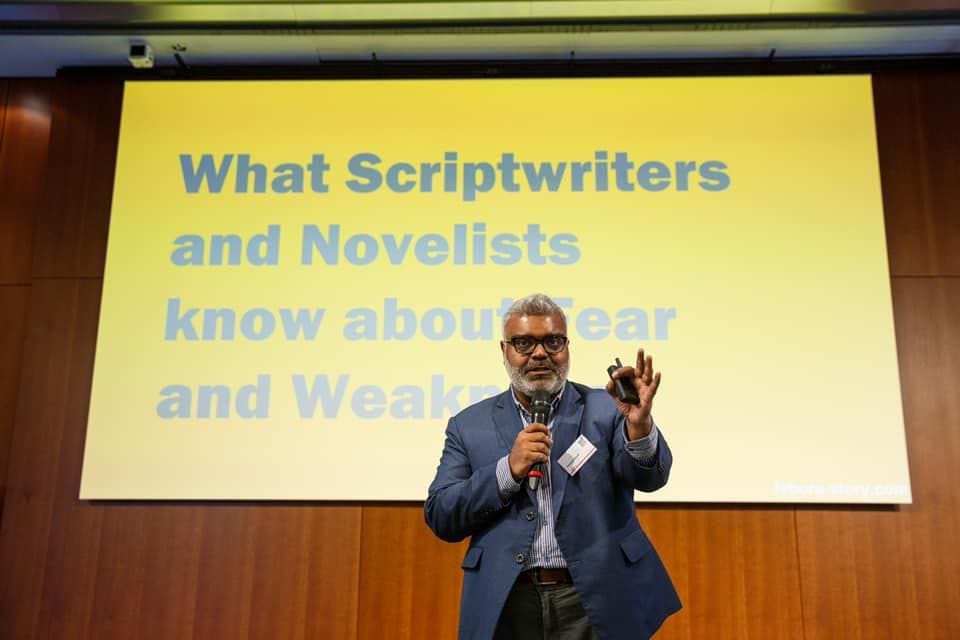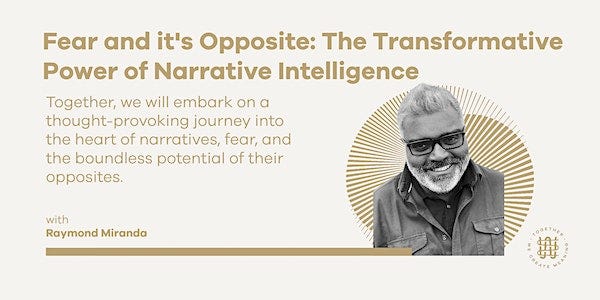What is the secret fear of the hero, that the hero doesn’t know?
Restorying fear with Raymond Miranda
This article is published in Create Meaning’s Learning Series. Every month, we put the spotlight on one community member doing amazing impact work.
Please, meet Raymond Miranda. Born in Kuala Lumpur, Malaysia, currently living in Berlin, Germany. Studied Musical Theory Writing at the University of New York. Teacher, storyteller, and story strategist.
Oh, by the way, Raymond is hosting a workshop on November 16 at We Create Meaning. Please come join us.
Hmmm. Something is missing.
What is it? Let me tell you.
It’s nothing short of magic, a spell, one that staggers and speaks with a cloud of silver crystals glittering in dark blue skies, like those you see in old Disney films. What’s missing is something that takes us out of our own world and into someone else’s, only for us to emerge on the other side of it, back in our own world but never the same. That something is a portal, a story.
A story is a portal. A coherent narrative that takes us from here to there and back again. If you’re like me, you might want to know why Raymond traveled from Kuala Lumpur across the globe to study in New York where he later became the head of a film fund, only to then move to Berlin and host narrative workshops.
Like Raymond, we’re all storied beings, telling stories and being told by stories. It’s through story that we make meaning of our experiences and stay afloat in a world that, honestly, doesn’t always make for easy meaning-making. And like every story, Raymond’s has obstacles. Loads of them, in fact. As Raymond reminds me, “We love watching a story because the obstacles are meaningful, but we don't think of them in our life that way. We jump the story. However, the story exists in the obstacles that become the training ground for the artist.”
In our conversation, we explored how Raymond went from madness to miracle, developing his own Fear and its Opposite method which he now uses with clients of all kinds.

The external story
Teaching: every story starts with fear, presented as phenomena in the external world.
The story: Raymond’s father was a journalist. He died of Alzheimer’s shortly after 9/11. But six years before his death, he was diagnosed with paranoid schizophrenia. One day Raymond walked into the door and saw his father staring out of the window. Into nothingness, or at least that’s what it seemed like to bystanders. For Raymond and his brother, knowing that their father had schizophrenia was a profound realization. The father they lived with and all the often incomprehensible ideas he shared suddenly made sense. Finally, there was a name for it.
Confrontation with the internal story
Teaching: the hero or protagonist realizes the external story isn’t as external as it once seemed and is called to confront the fear inside themselves.
At the time his father got diagnosed, Raymond had received a scholarship and was accepted into a new program at New York University. “It was musical theater writing. And it's I think still the only graduate program of its kind in the world. They take 11 writers and 11 composers and put them together for two years, so there was a lot of pressure in feeling that you had to be good.”
Yet little did he realize that he, too, would soon see the first “cracks” in his reality. “The school had renowned directors and instructors come in to talk about my work. Every time somebody said something negative — which was often in the context of people constantly commenting on the work in progress, it built scaffoldings of untruths. And while I think there’s a normal baseline of fear to think you’re not good enough, that you’re a fraud, I didn’t know that at the time. There were scaffoldings being built that took me past that normal, right? Thoughts kept spiraling furiously through my head: ‘That guy didn't look at my piece’, ‘he didn't like it today, and therefore... He doesn't like me altogether’.
And in these little cracks, you can build elaborate stories. You can build elaborate stories to survive. You can build elaborate stories to keep you shut off. I just began to know that I was isolating.” Raymond often couldn’t go to classes and didn’t show up for his final thesis presentation. He ended up on a friend’s couch, with only a worker’s visa.
Yet, thanks to his friends who saw potential in him to be a teacher, he became a lecturer of scriptwriting at a university. But while he kept his appearance to the outside world, deep inside a different story was brewing and breaking down other systems until eventually, he could no longer go to work.
“If you can name the subconscious fear of the hero that the hero doesn't know, and name the opposite of that fear, you potentially have the beginning and the end of the movie.”
The internal-internal story
Teaching: the hero or protagonist slowly reconciles with and exceeds their own fear, thus transforming into a different version of themselves.
The story: “One day, I started putting my thoughts out in mind maps and on post-its, as if I was developing a story. Day to day, I could eventually see that, wait, all these versions cannot exist together, they cannot all live in the same person. All of these ideas don't add up. But the externalizing of the thoughts so that they don't exist inside my head made a profound difference for sort of saving me.” This was a significant turning point in Raymond’s life. Once he started separating his thoughts from his thinking self, the thoughts started to lose their potency. The fear that once lasted 10 years would now only last 10 minutes. The fear had lost its story. Suddenly, there was a gap for a new story.
Fast-forward several years, and Raymond gradually turned his personal remedy into an incredibly useful method which he now uses in scriptwriting and with his business clients. “I had developed this exercise in teaching scriptwriting called ‘Fear and the Opposite’. If you can name the subconscious fear of the hero that the hero doesn't know, and name the opposite of that fear, you potentially have the beginning and the end of the movie.
As an individual, It is harder to know what the subconscious fear is that you don't know. But that was the exercise. What is the fear? Can I name the fear? And can I name the opposite? Because I had so much fear. And can I begin to entertain the notion of the opposite of the fear as the end of my story?”
“Maybe all you do is say, interesting, fear has arrived. In this fear is the transformative art. To notice when that fear comes up. When I speak for example to people dealing with climate anxiety, I often say stay with the fear. Don't tell the story of the fear in excessive loops.”
Collective schizophrenia
“The only thing I can do is keep facing the fear, transforming it, and seeing what emerges again. And in that, there's greater discovery. In that, I discover the hidden parts of my ego and I find greater forms of love.”
We also talked about the current challenges of humanity. It seems as if we’re at a juncture in time whereby the threads of the old, collective stories are starting to unravel, failing to adequately explain what’s really happening. The narratives we relied on that told us who we are, what is worth pursuing in life, what is good, and what it means to be human have started to lose meaning. For many whose stories have been silenced, it offers enormous possibilities for renewal and recognition. For others, the absence of a coherent story can feel daunting and fearsome.
All of this is very recognizable for Raymond. “I recognize this sort of world in which your stories don't hold, and they don’t hold fast enough. All these stimuli are affecting your story and none of it is adding up. So I started carefully insinuating that we will go into this sort of schizophrenic phase of humanity if we don't understand what's happening to us.”
Fear lives as a story that captures and enlists us, and makes us enslaved to its logic and stuck in its behavioral patterns. It moves through the invisible dark and finds us when we’re most isolated and at our most vulnerable. We need new stories to grapple with the moment, to help us move through and beyond the fear-ridden landscapes that are omnipresent these days. What if we could hold each other with greater compassion to look at our own fears and name their opposite? What beautiful stories could emerge from that?
As Raymond taught me, we can become more and more fearless, but fear will always exist. Fears are portals, and every time you step into one, a new one opens. Yet every passage brings you closer to your own truth. “I deeply care about the possibility (of facing your own fears), which makes me really humbled about the potential of what your own truth can do, right? And I think so often we're looking for people to tell us the truth, you know, to articulate the truth for us. The only thing I can do is keep facing the fear, transforming it, and seeing what emerges again. And in that, there's greater discovery. In that, I discover the hidden parts of my ego and I find greater forms of love.”
On Thursday, November 16, you have the opportunity to join us and explore Raymond’s tried-and-tested method “Fear and its Opposite” in a fun and courageous group setting. We hope to see you there!
In the meantime, don’t forget that the person sitting next to you on the U-bahn or the last autumn leaves and the chirping birds also have stories to tell. You just have to quieten your voice, prick up your ears, and listen.
This article is written and edited by Create Meaning’s community writer Niels Devisscher. If you value these publications, consider subscribing to our newsletter and getting the Supporter ticket at checkout to support our work.






